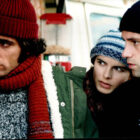In the grand tapestry of cinematic masterpieces, few threads are as delicately woven and intellectually stimulating as Michelangelo Antonioni’s “La Notte.” Released in 1961 as the second installment in his renowned trilogy. Alongside “L’Avventura” and “L’Eclisse,” “La Notte” stands as a timeless testament to Antonioni’s mastery of visual storytelling and existential exploration.
Set against the backdrop of Milan, “La Notte” unfolds over the course of a single day and night. Intimately capturing the disintegration of a marriage and the existential crises faced by its protagonists. In this bustling metropolis, sleek modernist architecture collides with desolate industrial outskirts, mirroring the emotional barrenness and existential ennui of the characters.
Antonioni’s meticulous approach to filmmaking is evident in every frame of “La Notte.” Collaborating once again with cinematographer Gianni Di Venanzo, Antonioni employs innovative visual techniques to convey the characters’ inner turmoil and the alienating nature of their surroundings. The film’s languid pacing and sparse dialogue amplify the sense of disconnection, drawing viewers into the characters’ internal struggles.
The society depicted in “La Notte” reflects the alienating effects of modernity and materialism on interpersonal relationships. Within Milan’s exclusive social circles, material possessions and social status serve as empty signifiers of success, offering only temporary reprieves from the existential void. Against this backdrop of opulence and decadence, Antonioni exposes the fragility of human connections and the inherent alienation of modern life. Inviting viewers to confront the existential dilemmas that lie at the heart of the human condition.
Within the intricate web of “La Notte,” the relationships between the three central characters—Giovanni, Lidia, and Valentina—serve as a microcosm of broader themes of alienation and disconnection. Giovanni, a celebrated author, embodies the archetype of the detached intellectual, while Lidia, his wife, exudes quiet resilience tinged with longing. Valentina, a young socialite, serves as a catalyst for their existential crisis, her magnetic presence destabilizing the fragile equilibrium of their marriage.
One of the most poignant scenes unfolds during a lavish party at the Palazzo Mondadori, where Giovanni and Lidia confront the emptiness of their social milieu against the backdrop of Milan’s modernist architecture. Another pivotal moment occurs in Parco Sempione, where Giovanni and Valentina engage in a flirtatious pas de deux amidst the urban landscape. Highlighting the fleeting nature of their connection. Meanwhile, the industrial landscapes of the Fiera di Milano serve as a stark backdrop for Giovanni and Lidia’s confrontation. With the profound void at the heart of their relationship.
Upon its release, “La Notte” polarized critics and audiences alike with its unflinching portrayal of existential angst. While some hailed it as a masterpiece of modern cinema, others criticized its perceived lack of narrative coherence. However, over time, the film has garnered widespread acclaim for its haunting beauty and profound exploration of the human condition. It continues to influence filmmakers and scholars, cementing its status as a timeless classic.
In conclusion, “La Notte” stands as a profound meditation on the emptiness and disconnection that permeate modern urban life. Through its evocative imagery, nuanced performances, and profound thematic depth, the film beckons viewers to confront the elusive nature of meaning and the fragility of human connections in a world consumed by loneliness and despair.
Watch the movie on Movieitaly+
Read more here!







20 Must-Watch Italian Films for Every Cinema Lover – Next Movie Stop
[…] © Visit Italy with Movies […]